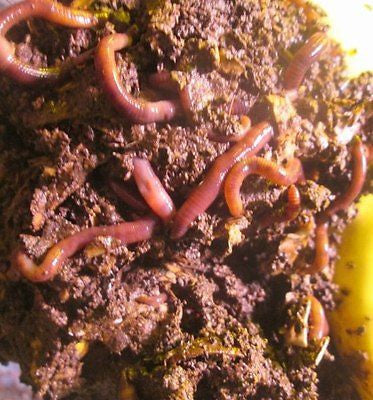Red wigglers: For vermicomposting
Red wigglers: For vermicomposting
Blog Article
Transform Your Garden With Red Wigglers: Idea
By developing a standard worm container and recognizing the nutritional requirements of these remarkable animals, garden enthusiasts can substantially improve soil top quality and plant health. The process of converting organic waste right into rich, productive spreadings is both straightforward and fulfilling.

Advantages of Red Wigglers
Red wigglers, scientifically recognized as Eisenia fetida, are typically hailed as nature's composting champions. These impressive worms serve numerous key advantages that can significantly improve yard wellness and efficiency.

Another noteworthy benefit of red wigglers is their capability to minimize waste. By composting natural materials that would certainly otherwise add to garbage dump waste, they play a crucial function in lasting gardening techniques. Incorporating these worms right into your horticulture regimen can lead to boosted yields, healthier plants, and a more vivid yard atmosphere, making them very useful allies for gardeners seeking to boost their ecological footprint.
Establishing Up a Worm Container
Creating a worm bin is a crucial step for any individual aiming to harness the benefits of red wigglers in their gardening initiatives. An ideal worm bin can be made from various materials, consisting of plastic containers, wood crates, or commercially offered worm containers. The initial factor to consider is dimension; a bin that is at least 2 feet broad, 3 feet long, and 1 foot deep is typically excellent for a small to medium number of worms.
Next, guarantee appropriate drainage and ventilation. Drill holes in all-time low for excess wetness to get away and in the sides for air movement. It is necessary to develop a bedding layer, utilizing materials such as shredded newspaper, cardboard, or coconut coir to offer a comfortable atmosphere for the worms. The bed linen must be wet yet not soaked, appearing like a wet sponge.
Place the container in an area that keeps a regular temperature level, ideally between 55 ° F and 77 ° F. Avoid direct sunshine or severe chilly, as these conditions can harm the worms. Once the container is established up, enable the bed linen to go for a few days prior to presenting the red wigglers, ensuring they have a growing environment in which to grow.
Feeding Your Red Wigglers
As soon as the worm bin is developed and the red wigglers are presented, appropriate feeding becomes vital to keeping a healthy worm population. Red wigglers grow on a varied diet, primarily being composed of kitchen area scraps and organic products. Suitable foods include veggie peels, fruit scraps, coffee grounds, and crushed eggshells. It is vital to avoid feeding them meat, dairy products, or oily foods, as these can develop unpleasant odors and attract parasites.
When introducing food, slice the scraps right into smaller items to promote quicker usage. Furthermore, hide the food below a layer of bed linens material to avoid fruit flies and various other nuisances. Screen the feeding regularity; a basic rule is to supply food every 1-2 weeks, relying on the number of worms and the quantity of food waste created.

Collecting Worm Castings
Just how can you tell when it's time to harvest worm castings from your bin? The readiness of worm spreadings is shown by a couple of vital indicators. Initially, the product in the container must show up dark, brittle, and abundant in structure, looking like a fine soil. Additionally, the original food scraps should be significantly damaged down or nearly unrecognizable, showing that the worms have actually successfully processed them.
One more indicator more tips here is the decrease in worm activity; as the spreadings gather, worms have a tendency to migrate towards fresher food resources. If you notice a decrease in worm motion and the existence of castings at the end of the bin, it's a clear signal that harvesting is due.
To collect, delicately scoop out the castings, taking treatment to lessen disturbance to the worms. A popular approach includes dividing the spreadings using light; worms often tend to tunnel away from the light, enabling you to collect the castings more easily.
Collecting on a regular basis, around every 3 to six months, guarantees a continuous supply of this nutrient-rich change for your gardening undertakings. Keep in mind, the top quality of your castings straight affects the wellness of your plants.
Utilizing Spreadings in Your Garden
(red wigglers for sale near me)Utilizing worm spreadings in your yard can substantially improve soil health and plant development - red worms. These nutrient-rich natural fertilizers offer important macro and trace elements, improving the overall fertility of your soil. By integrating worm spreadings right into your yard beds, you can promote valuable microbial task, which aids in nutrient availability and enhances soil framework
To use worm spreadings successfully, blend them right into the leading few inches of soil before growing. This makes certain that nutrients are readily obtainable to your plants. Conversely, you can produce a nutrient-dense fluid plant food by steeping worm castings in water for a week, then using the resulting "worm tea" directly to your plants. This technique not just offers immediate nutrients yet also urges healthy root development.
Worm spreadings likewise boost wetness retention within the soil, reducing the demand for constant watering. Their all-natural pH equilibrium makes them appropriate for numerous plant types, from veggies to ornamentals. Routinely including worm castings into your horticulture routine can bring about robust plant development, increased yields, and a general healthier garden ecological community. Embrace the benefits of worm castings for a flourishing and sustainable yard.
Verdict
By establishing a worm bin, providing appropriate food, and routinely harvesting nutrient-rich castings, garden enthusiasts can foster a lasting community. The usage of worm spreadings and "worm tea" even more contributes to moisture retention and nutrient availability in the soil.
Report this page